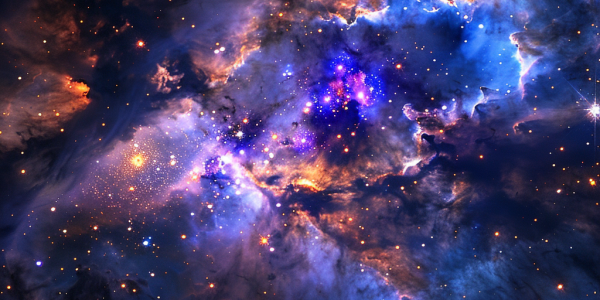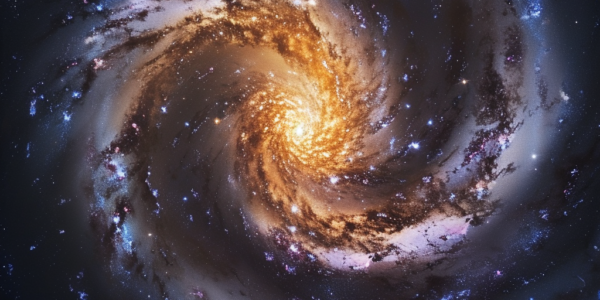First Magnetar Flare Detected Outside Our Galaxy: A Game-Changing Discovery in Astrophysics
Discover the groundbreaking detection of the first magnetar flare outside our galaxy, challenging previous notions about gamma-ray bursts and opening new frontiers in astrophysics. Learn how the Integral gamma-ray observatory identified the burst in the nearby galaxy M82, shedding light on the complex nature of cosmic phenomena and the potential origins of magnetars.
James Webb Space Telescope Reveals Mesmerizing Image of Tumultuous Area in Space
The James Webb Space Telescope unveils a mesmerizing image of a tumultuous area near the center of our galaxy, 25,000 light years away. This image showcases never-before-seen features that have left astronomers puzzled. Launched in 2021, the telescope’s advanced capabilities allow it to observe the near-infrared spectrum, capturing objects previously undetectable by the Hubble Space Telescope. The recent image focuses on Sagittarius C, a region densely populated with stars and proto-stars, including a colossal proto-star exceeding 30 times the mass of our sun. Astronomers aim to test star formation theories and understand the composition of the universe. The image reveals enigmatic phenomena, such as a blue cloud of ionized hydrogen, sparking excitement among astronomers as they uncover the mysteries of space.
UC Berkeley to manage $300 million NASA mission to conduct first all-sky survey of ultraviolet sources in the cosmos
UC Berkeley has been selected to manage a $300 million NASA mission called UVEX (UltraViolet EXplorer) that is set to launch in 2030. The mission, led by the Space Sciences Laboratory (SSL) at UC Berkeley, will conduct the first all-sky survey of ultraviolet (UV) sources in the cosmos. The UVEX mission, headed by Fiona Harrison, a UC Berkeley Ph.D. recipient and professor of physics at the California Institute of Technology, aims to provide valuable insights into the evolution of galaxies and stars, both in the present and the distant past. This initiative is expected to complement other ongoing or planned surveys by other missions, including the optical and infrared Euclid mission led by the European Space Agency with NASA contributions, and NASA’s Nancy Grace Roman Space Telescope. According to Daniel Weisz, a science team leader for the UVEX mission and a UC Berkeley associate professor of astronomy, the launch of UVEX will mark the first time that the entire sky will be covered from the UV all the way through the infrared. This comprehensive coverage is considered groundbreaking, as ultraviolet emissions, which come from hot objects, are typically blocked by Earth’s atmosphere and must be studied from space. The survey will specifically focus on hot, massive blue stars, many of which are believed to be members of binary star systems, as well as exploding stars. UVEX will map the distribution of these ‘stripped’ stars in galaxies around the Milky Way. Additionally, the telescope will carry a UV spectrograph, jointly built by UC Berkeley and Caltech, to record detailed information about the UV wavelengths. With the ability to capture ultraviolet coverage of the entire sky, the UVEX mission is poised to provide groundbreaking insights into our understanding of galaxies, stars, and stellar explosions.
NASA’s Hubble Telescope Captures Virgo Galaxy Cluster 52 Million Light-Years Away
NASA’s Hubble Telescope captures stunning image of the Virgo galaxy cluster, located 52 million light-years away. The post reveals the impact of ram pressure on star formation within the galaxies, drawing awe and admiration from users on Instagram. NASA’s ability to captivate audiences with its breathtaking glimpses of the cosmos continues to fuel fascination and wonder about the mysteries of outer space.
Study Explores Dark Matter’s Role in Galactic Dynamics
Dark matter, the elusive substance that makes up much of the matter in the universe, continues to intrigue astronomers. A recent study, detailed in the pre-print server arXiv, delves into the speed at which dark matter can move and its…
NASA’s Hubble Space Telescope Captures Breathtaking Images of ‘Galactic Romance’
NASA’s Hubble Space Telescope has recently captured breathtaking images showcasing what the space agency refers to as a ‘galactic romance’. The stunning pictures depict cosmic collisions between galaxies, offering a mesmerizing glimpse into the captivating phenomena of celestial interactions. Shared…
NASA Captures Amazing Photo of Spiral Galaxy UGC 11105
Top Headlines: Female Woolly Mammoth’s Lifetime Movements Tied to Ancient Alaskan Hunter-Gatherer Camp Meet Bustingorrytitan shiva, New Gigantic Titanosaur from Argentina NASA Announces End of Ingenuity Mission Fossil of Giant Triassic Amphibian Unearthed in Brazil Paleontologists Discover New Species of…
Astronomers Discover Twisted ‘Train-Wreck Galaxy’ After Violent Galactic Collision
A team of astronomers recently made a fascinating discovery while studying the aftermath of a violent galactic collision. Using the Gemini South Telescope, the scientists investigated the twisted galactic disk of NGC 4753, a lenticular galaxy located around 60 million…
Study Suggests Universe May Be Younger Than Previously Thought
A recent study published in Nature Astronomy has suggested that the universe might be younger than previously thought. The study, conducted by a team of researchers, analyzed the kinematics of satellite galaxies around massive galaxy groups and found evidence of…
Groundbreaking Discovery in the Study of the Epoch of Reionization
Researchers have made a groundbreaking discovery in the study of the epoch of reionization, shedding light on the enigmatic Lyman-α emission in the early galaxies. The recent observations from the James Webb Space Telescope have sparked a renewed debate about…










